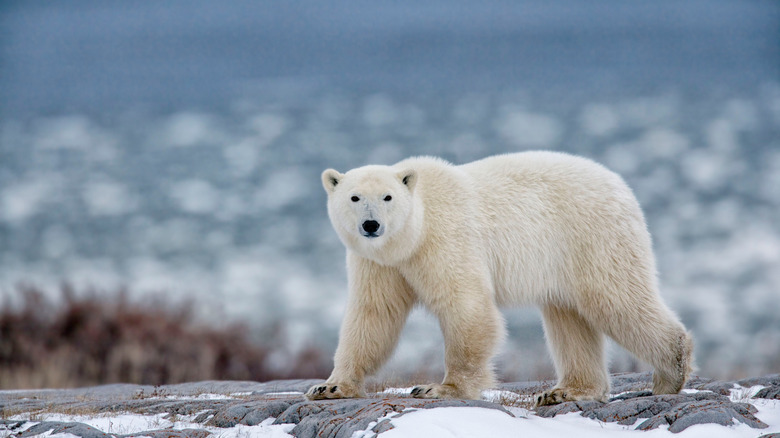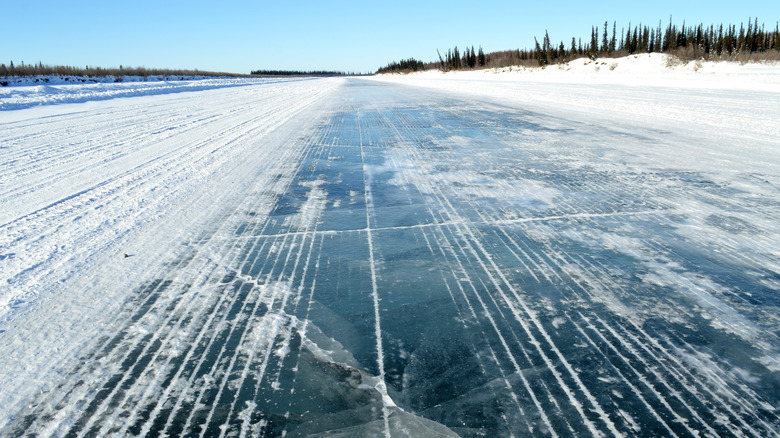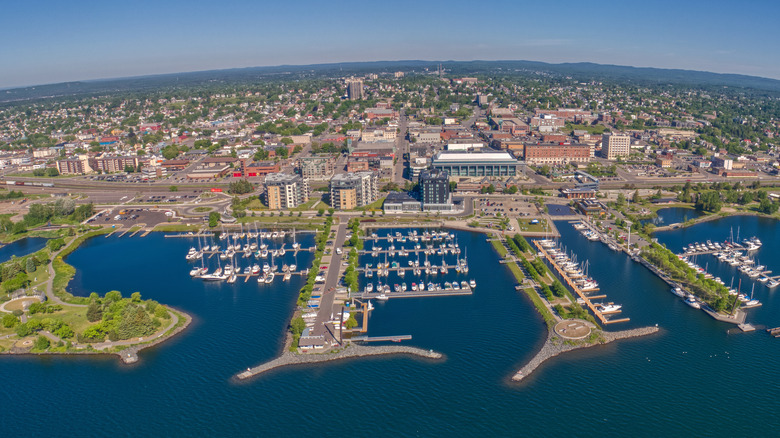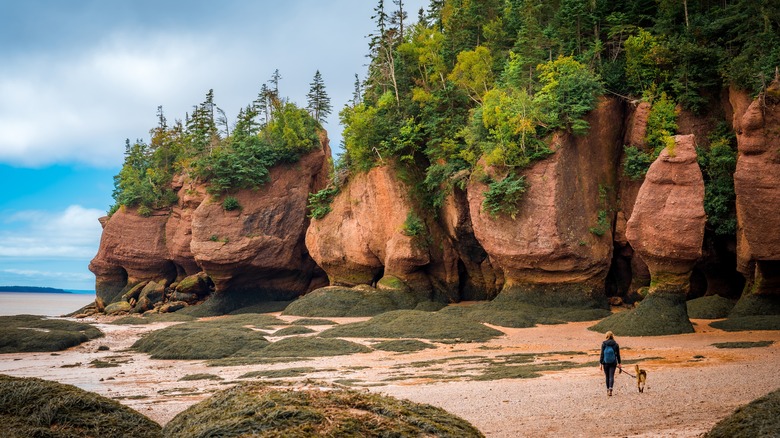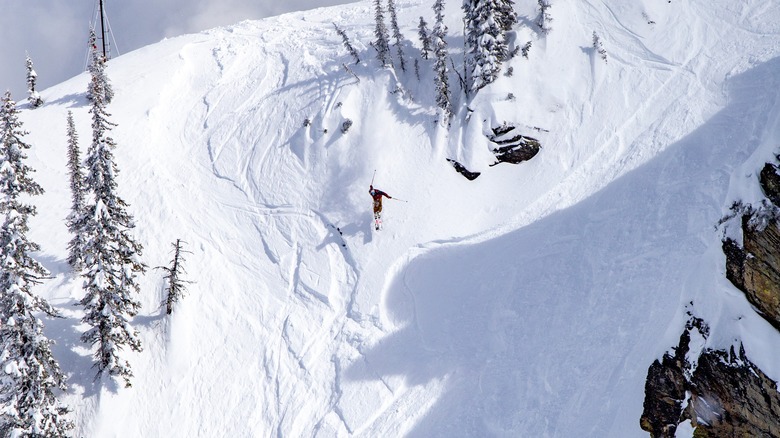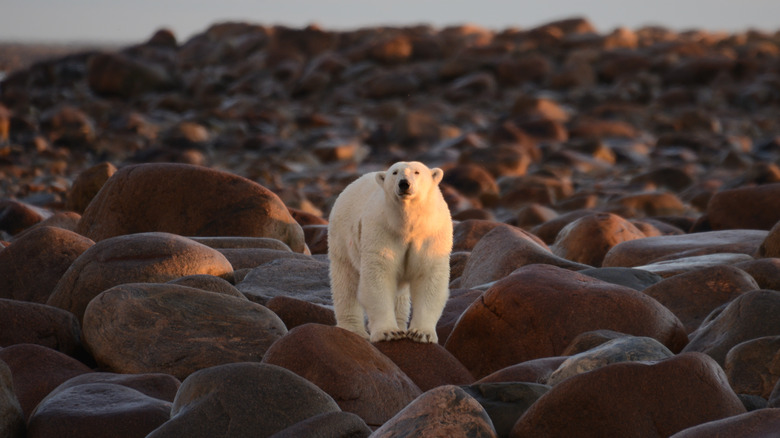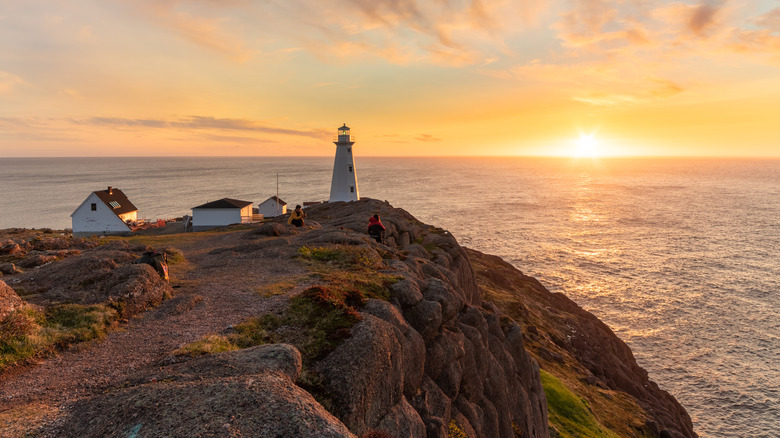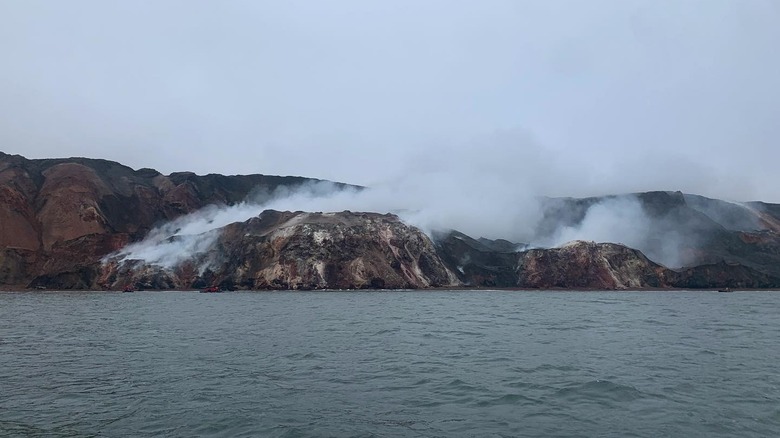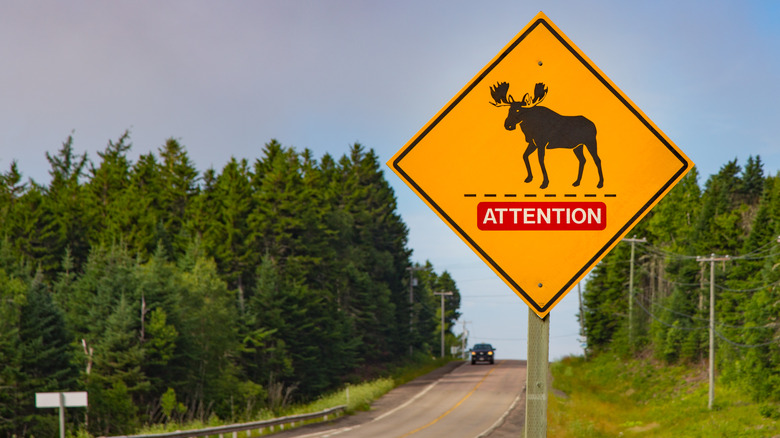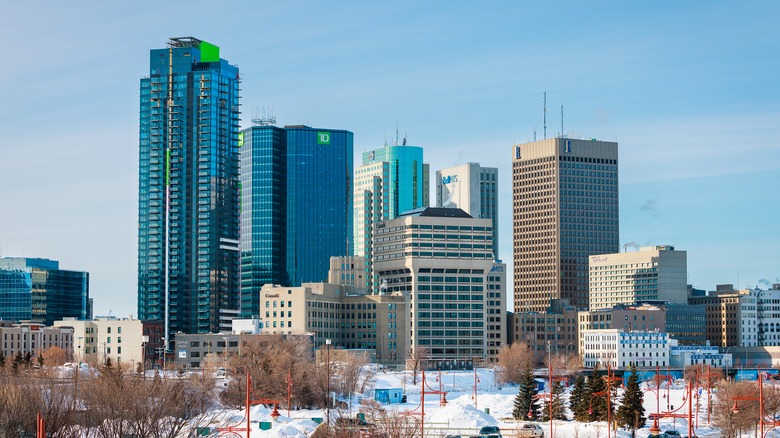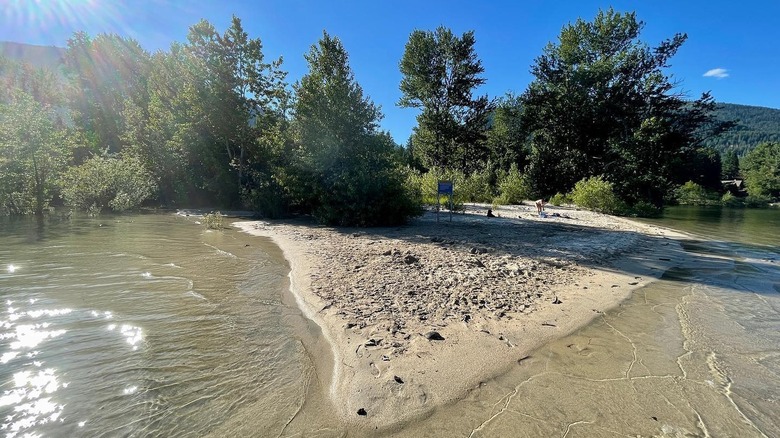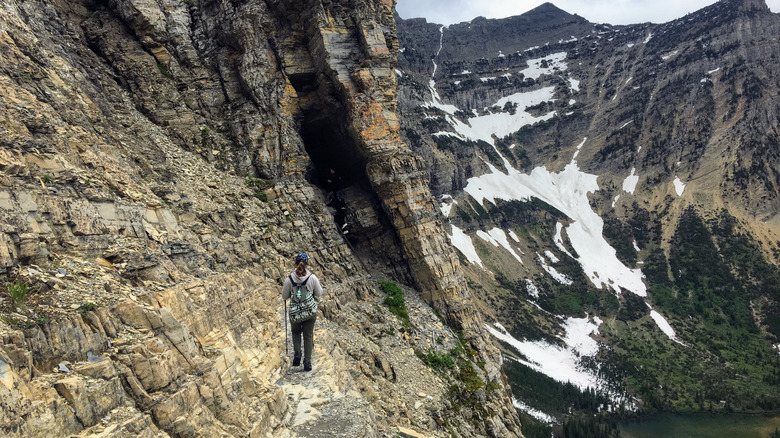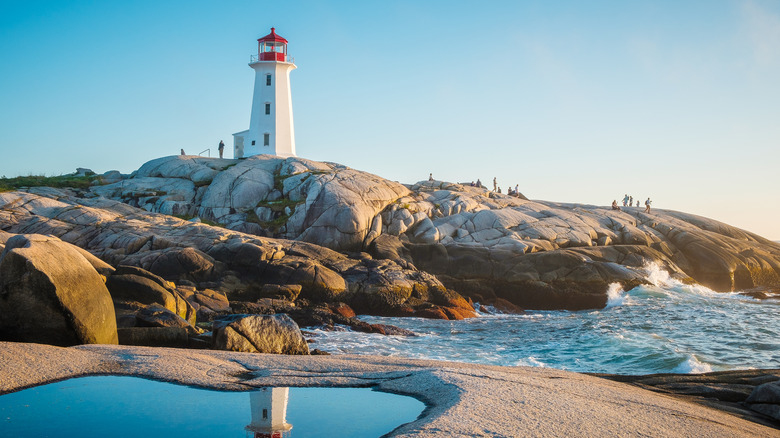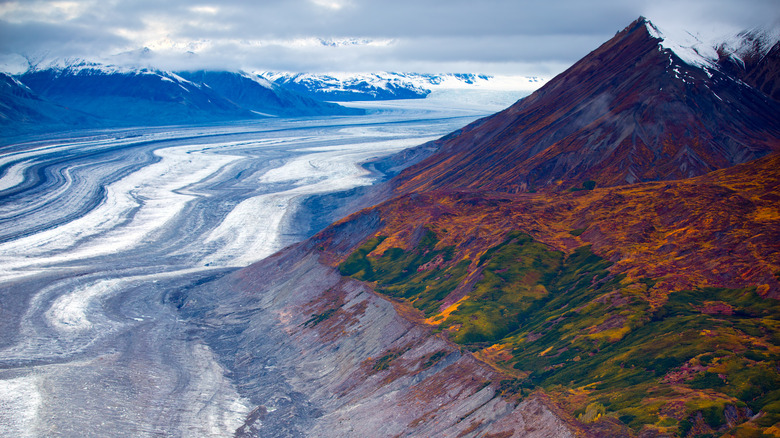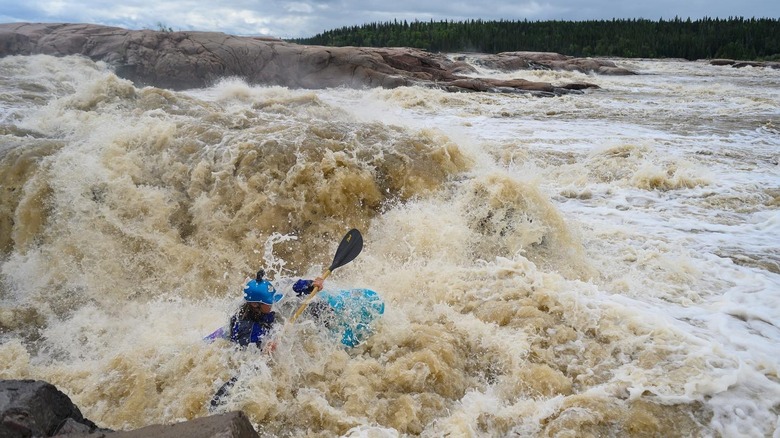Dangerous Vacation Spots In Canada
"Dangerous" may not be the first word that comes to mind when you think of Canada. After all, Canadians have garnered a reputation for their peaceful and friendly natures — except maybe when it comes to hockey. However, some spots in Canada can pose a risk for travelers, whether due to high crime rates or natural hazards. Like any travel destination, you should remain aware of the dangers you might encounter while exploring Canada's provinces and territories.
It's no secret that Canada contains some pretty wild and fascinating landscapes. You'll encounter incredibly beautiful spots across the country, ranging from the frozen tundra in the north to rugged mountains and windswept coastlines. Exploring these areas can prove rewarding, but you'll also need to remain mindful of your surroundings and prepare for what you might encounter in the wilderness. Canada also has some cities and roadways that can be dangerous if you find yourself in the wrong place at the wrong time. If you're planning a trip to the Great White North, you might want to exercise extra caution in these vacation spots.
Mackenzie Valley Winter Road, Northwest Territories
In Canada's Northwest Territories, winter brings a new means of transportation: ice roads. Waterways freeze over and become solid routes passable only for a few months, usually from December to early spring. Also called winter roads, these routes make for unique trips. But be warned — they can also be some of the world's scariest and most dangerous roads. The icy conditions, sub-zero temperatures, and remoteness mean they are not for the faint-hearted or unprepared.
The Mackenzie Valley Winter Road is one of Canada's longest and most treacherous ice roads. It runs for about 300 miles, from the community of Wrigley on the Mackenzie River all the way to Fort Good Hope. Winter weather on the road can be volatile. Wind can lead to snow drifts and white-out conditions. Warmer weather can initiate thawing, which has caused vehicles to plunge into the water or get stuck in mud and slush. You'll find few places to stop for fuel or food along the route, and response times can be extended in an emergency. If you intend to travel this winter road, the Government of Northwest Territories suggests ensuring your vehicle is winter-ready and bringing extra fuel and a winter survival kit.
Thunder Bay, Ontario
While Canada has relatively low levels of violent crimes compared to many other countries in the world, it does have its fair share of urban issues. When it comes to homicides, Thunder Bay earned the title of murder capital of the country for 2022. Statistics Canada reported that Thunder Bay had the highest homicide rate of all Canadian metropolitan areas in 2022, with roughly 12 homicides per 100,000 people. That's five times higher than Canada's national average.
Although Thunder Bay has frequently had the highest homicide rate in Canada (it also topped the list in 2018, 2019, and 2020), it should be noted that the city only had 15 total homicides in 2022. That's not exactly outrageous when you consider that Toronto had 136 homicides in the same year. Plus, as a tourist, it's doubtful that you would be a victim of murder. Chances are you'll be able to stroll along the Lake Superior waterfront, visit the Fort William Historical Park, and hike in the Cascades Conservation Area without encountering violent crime.
The Bay of Fundy, Nova Scotia and New Brunswick
The Bay of Fundy, a funnel-shaped bay between the provinces of Nova Scotia and New Brunswick, features soaring cliffs, beautiful beaches, and the highest tides in the world. The water can rise to 52 feet at high tide in some parts of the bay. It's a fascinating place to visit, but heed the warning signs while strolling along the flats. The tides come in quickly, so you don't want to get stuck beyond a headland with no escape.
According to Cliffs of Fundy Geopark, "The rising tide can flood parts of some tidal flats and sand bars faster than you can run. The rising tide may block your access route around a headland, creating a 'pinch point.' Many coves are completely flooded at high tide, with no escape route up the steep cliffs." Many individuals have had to be rescued from the Bay of Fundy's rising tides over the years. In 2017, three people and a dog had to be airlifted from Noel Shore when they got trapped by the tides. In 2022, rescuers managed to drag two adults and a five-year-old boy out of the rising bay waters just minutes before the ocean swept them away.
Revelstoke, British Columbia
British Columbia is renowned for its snow-capped mountains and world-class ski resorts. But where there are mountains and heavy snow, there are also avalanches. Revelstoke and the surrounding areas can be prone to avalanches depending on the snow conditions. In the past, several avalanches in the area have been deadly. In 2003, seven skiers were killed in an avalanche on Durrand Glacier. Just a few weeks later, seven schoolchildren died in another avalanche in the Connaught Creek Valley. In 2023, an avalanche near Revelstoke took out a heli-skiing group, killing two tourists.
Of course, these events don't mean you can't enjoy Revelstoke's epic ski resorts. You just have to be aware of the dangers. Stick to marked trails and watch for signs alerting skiers and snowboarders of avalanche zones. Tourism Revelstoke suggests bringing gear like a transceiver, shovel, and probe and ensuring you know how to use them if you want to explore the backcountry. It also recommends checking the forecast on Avalanche Canada and taking an avalanche training course. For those with backcountry experience, Revelstoke Mountain Resort has an Avalanche Ranch where you can practice your transceiver skills.
Churchill, Manitoba
During October and November, polar bears can outnumber the residents of Churchill, Manitoba. Every year, nearly 1,000 bears migrate to the area to wait for the ice to freeze on Hudson Bay so they can hunt seals. This has earned the town the title of "polar bear capital of the world." You probably don't want to wander too far from the main streets there, as the bears have been known to wander into town. Several companies offer polar bear tours in custom-built tundra vehicles if you want to see the apex predators from a safe distance.
Great White Bear Tours offers excursions to see polar bears on their Polar Rovers, which have elevated, see-through decks so that you can safely view them out of their range of reach. The vehicles are heated, wheelchair accessible, and have reclining seats and restrooms. If you want more time with the bears, Natural Habitat Adventures runs the Tundra Lodge, a unique accommodation on wheels where you can watch the bears roam the land in the Churchill Wildlife Management Area.
Cape Spear, Newfoundland
Cape Spear is the easternmost point in North America and a stunningly scenic spot. At the top of the cliff sits the Cape Spear Lighthouse, a historic Maritime lighthouse standing as a beacon high above the blue waters of the Atlantic Ocean. Depending on the time of year, you may spot humpback, minke, and fin whales frolicking in the waves below. It's a breathtaking area where you can catch the sunrise and hike along the trails. Just be sure not to venture off the paths, as the cliffs and rocky coastline can be dangerous.
According to Parks Canada, "The terrain and coastline at Cape Spear are treacherous. High winds, irregular tides and dynamic ocean actions make for a dangerous combination when visitors stray from the designated hiking trails. Though Park Staff are on site, visitors must also exercise caution and responsibility for their own safety." Several signs denote the safe areas, and others warn wanderers to stay away from the cliffs and the rocks by the water as a reminder to visitors. They're not for nothing, as several people have fallen off the cliffs or been swept out to sea there. Some have managed to survive with just broken bones, while others have not been so lucky.
Smoking Hills, Northwest Territories
Some cliffs have been burning on a section of Cape Bathurst's coastline along the Arctic Ocean for centuries. The Smoking Hills is a unique site where oil shales containing lignite deposits ignite when exposed to air. The high temperatures turn the rocks into red, white, brown, and yellow shades. As the smoke dissipates into the air, it releases sulfur dioxide and heavy minerals into the ground and ponds nearby. It's a toxic, desolate place that most people stay far away from.
No roads lead to the Smoking Hills, which is probably a good thing. The only way to reach the hills is by boat or helicopter. Stepping foot on the site is not recommended. As research scientist Steve Grasby explained on the Simply Science podcast, "It's just really like hell on Earth. Everything about it is absolutely horrible. The ground is really hot. It's black. Everywhere is black. It's just kind of deep muck that you walk through ... And then you get this strong smell of hydrogen sulfide. The steam coming out is actually sulfuric acid, so you have to wear all this protective gear, or else you're just going to burn your eyes and your throat. It would just probably kill you instantly if you got too close to these sites. So, really, just everything about it says you do not belong here."
Route 10, New Brunswick
One of the dangers of driving along many of Canada's highways is the risk of running into a moose. These colossal creatures can easily total a car, and many moose collisions have caused fatalities. Route 10 in New Brunswick is particularly bad for moose-related accidents. The highway runs for about 89 miles between Fredericton and Sussex, and it is the site of many of the nearly 400 moose collisions in the province every year.
If you're planning a road trip in New Brunswick, it helps to have some basic moose knowledge. First, the spring and early summer are when you might see more moose on the roads because this is calving time for females. This means the calves from the previous year set off on their own, and some end up wandering along highways and roads. Moose also head to the roads during the warmer months to seek respite from the forest heat and find fresh vegetation. Secondly, moose are crepuscular animals, meaning they are most active at dawn and dusk. This is doubly dangerous for drivers because of the low visibility at these times. No matter what time of year or hour you're on the road, it's important to remain vigilant. Drive at a reasonable speed, keep your eyes on the path ahead, and stay alert.
Winnipeg, Manitoba
Thunder Bay may be the murder capital of Canada, but Winnipeg had the highest increase in crime severity in the country, according to the Canada Crime Severity Index. Data from the report shows that Winnipeg had a 20% increase in crime from 2021 to 2022. The city has the second highest homicide rate in the country (after Thunder Bay), and other violent crimes like assaults are on the rise. According to a CTV poll, one in four people said they had been a victim of a crime within the past three years.
Many factors are contributing to the high crime rate in Winnipeg. Experts cite economic instability, addiction, and the increase in weapons and street gangs. Despite these challenges, Winnipeg remains an underrated Canadian city with much to offer tourists, including interesting museums, art galleries, parks, and festivals. It's worth visiting, but tourists should be mindful of the issues the city faces. Like any travel destination, you must be aware of your surroundings and take standard precautions like avoiding walking alone at night and not flashing too much cash around.
Six Mile Beach, Nelson, British Columbia
Six Mile Beach looks like a gorgeous spot to swim on a hot summer day. The soft golden sand extends into a long spit that slopes into the deep blue waters of Kootenay Lake. But ask a local what the swimming is like, and they'll probably tell you to be very wary. The fast-running current along the spit's west side and the sandbar's tip have dragged out numerous swimmers. Even strong swimmers have been pulled out, and more than a few people have drowned.
You wouldn't think a lake would have the power to pull people into its depths, but the conditions at Six Mile Beach are unique. The tip of the sandbar is unstable and drops to a depth of up to 65 feet. When the water flows alongside this drop-off, it gains momentum that can pull swimmers down. Resident Lucille Ottewell told reporter Tyler Harper of the Nelson Star, "The sand starts to just suck you in and you can't get out because it's pulling on your legs. So if you've gone out far enough and try to get back, it breaks off and sucks you down." Locals have erected signs on the beach to warn people of the risks, and visitors would be wise to heed their warnings.
Crypt Lake Trail, Alberta
The Crypt Lake Trail in Waterton Lakes National Park is a must-visit destination for avid hikers. Along the trail, you can take in waterfalls, canyons, and the striated peaks of the Rocky Mountains. However, you better have some steely nerves if you want to hike the entire path. It starts relatively easy, but soon, you'll have to traverse a series of steep switchbacks, then cross a narrow ledge over a cliff, squeeze through a cave, and scale the side of the rocks using only a steel cable as a guide. One wrong step and you could find yourself careening to the ground below.
If you're an experienced hiker up for the challenge, the journey begins in Waterton Park, about a three-hour drive from Calgary. You'll need to take a boat across Waterton Lake to get to the trailhead at Crypt Landing. From there, a narrow path takes you up into the forest and then along winding tracks on the mountain. Eventually, you'll reach tight trails in the rock that lead to the cave. Shimmy through the tunnel to the lofty ledge high above the canyon floor. Follow the steel cable along the rocky footpath, and finally, you'll reach beautiful Crypt Lake. Once there, you can cool off in the water and congratulate yourself on braving such a challenging trail.
Peggy's Cove, Nova Scotia
Peggy's Cove is one of Nova Scotia's most iconic and beloved landmarks. Huge rounded rocks line the coast, and the postcard-perfect Peggy's Point Lighthouse watches over the South Shore. The small village on the cove is just as picturesque, with wooden houses overlooking the docks and bays where fishing boats bob. It's only an hour's drive from the capital city of Halifax, making it a popular spot for tourists and locals alike. However, note that despite its charm, Peggy's Cove also has its dangers.
The granite rocks at Peggy's Cove are smooth and curved, making them incredibly slippery when wet. The rocks closest to the ocean take on a black hue when they get doused with waves, which is a sign that they are extra slick. Many people have slipped on the rocks and fallen into the ocean at the site. Sudden waves can crash onto the rocks anytime, even on clear days. In the event of an accident, rescues are challenging due to the rough surf. After a tragic drowning at Peggy's Cove in 2022, a safety patrol was formed to warn visitors to stay away from the black rocks. However, it should be noted that they are not lifeguards. This group simply intervenes when people get too close to the water's edge. If you ignore their warnings and fall into the water, there's a good chance it won't end well.
Kluane National Park and Reserve, Yukon
Spanning more than 13,000 square feet, Kluane National Park and Reserve is an area of incredibly pristine natural beauty. It's home to Canada's tallest mountain, Mount Logan, and glaciers, lakes, and boreal forests. It's also a pretty wild spot where you'll want to keep your wits about you. Some dangers include black and grizzly bears, earthquakes, rivers with powerful rapids, and sudden blizzards.
Dangers aside, Kluane National Park and Reserve is a spectacular spot if you love nature. It's located in the southwest corner of the Yukon province, about a two-hour drive from the capital city of Whitehorse. It's a hiker's dream with trails that range from easy strolls through the wilderness to hardcore backcountry treks through the mountains and glaciers. It's an awe-inspiring place, but one you want to be well prepared for. Parks Canada recommends bringing a satellite phone or GPS messenger device, bear spray, a first aid kit, and warm clothing. Inexperienced hikers might want to consider hiring a local guide.
Slave River, Northwest Territories
Stretching for 258 miles from northern Alberta to the Great Slave Lake in the Northwest Territories, the Slave River has roiling rapids that churn through rock ledges and shelves. The whirlpools and crashing waves make it one of the world's most thrilling places to go whitewater rafting. But it should only be tackled by expert rafters with experience riding massive swells and dealing with tricky channels and tornado-like holes. You'll also need a strong dose of courage to handle the gnarly sections, one of which is called the Rapids of the Drowned.
The best place to access the Slave River for whitewater rafting is the town of Fort Smith on the border of Alberta and the Northwest Territories. You can reach all four main rapids: Rapids of the Drowned, Mountain, Pelican, and Cassette. Each set of rapids runs for a few miles and has unique features like rolling surf, chutes, whirlpools, and drops. Experts recommend taking a local guide if it's your first visit to the Slave River. In addition, it's best to set out in groups for safety and take a float bag.
